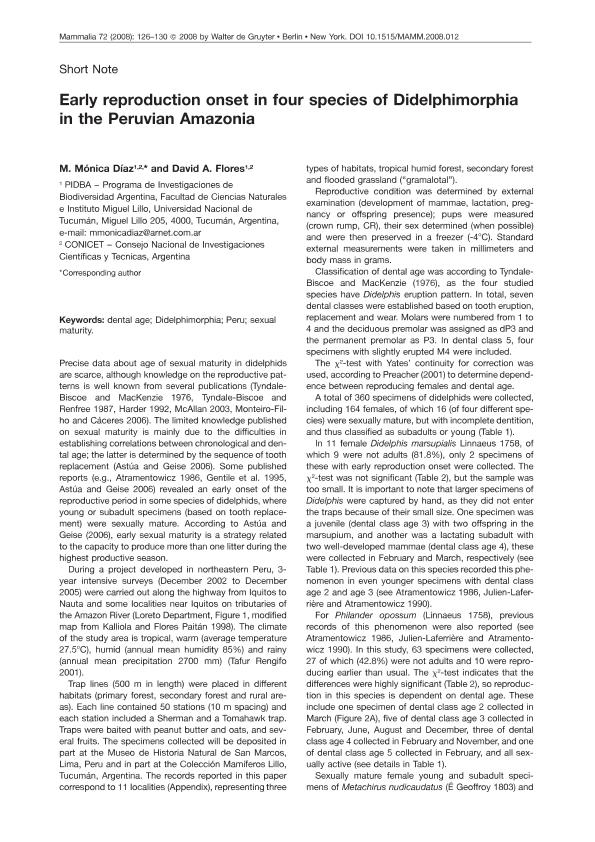Mostrar el registro sencillo del ítem
dc.contributor.author
Díaz, María Mónica

dc.contributor.author
Flores, David Alfredo

dc.date.available
2019-09-24T20:17:46Z
dc.date.issued
2008-06
dc.identifier.citation
Díaz, María Mónica; Flores, David Alfredo; Early reproduction onset in four species of Didelphimorphia in the Peruvian Amazonia; De Gruyter; Mammalia; 72; 2; 6-2008; 126-130
dc.identifier.issn
0025-1461
dc.identifier.uri
http://hdl.handle.net/11336/84326
dc.description.abstract
Precise data about age of sexual maturity in didelphids are scarce, although knowledge on the reproductive patterns is well known from several publications (TyndaleBiscoe and MacKenzie 1976, Tyndale-Biscoe and Renfree 1987, Harder 1992, McAllan 2003, Monteiro-Filho and Cá ceres 2006). The limited knowledge published on sexual maturity is mainly due to the difficulties in establishing correlations between chronological and dental age; the latter is determined by the sequence of tooth replacement (Astúa and Geise 2006). Some published reports (e.g., Atramentowicz 1986, Gentile et al. 1995, Astúa and Geise 2006) revealed an early onset of the reproductive period in some species of didelphids, where young or subadult specimens (based on tooth replacement) were sexually mature. According to Astúa and Geise (2006), early sexual maturity is a strategy related to the capacity to produce more than one litter during the highest productive season.
dc.format
application/pdf
dc.language.iso
eng
dc.publisher
De Gruyter

dc.rights
info:eu-repo/semantics/openAccess
dc.rights.uri
https://creativecommons.org/licenses/by-nc-sa/2.5/ar/
dc.subject
DENTAL AGE
dc.subject
DIDELPHIMORPHIA
dc.subject
PERU
dc.subject
SEXUAL MATURITY
dc.subject.classification
Zoología, Ornitología, Entomología, Etología

dc.subject.classification
Ciencias Biológicas

dc.subject.classification
CIENCIAS NATURALES Y EXACTAS

dc.title
Early reproduction onset in four species of Didelphimorphia in the Peruvian Amazonia
dc.type
info:eu-repo/semantics/article
dc.type
info:ar-repo/semantics/artículo
dc.type
info:eu-repo/semantics/publishedVersion
dc.date.updated
2019-07-10T14:41:50Z
dc.journal.volume
72
dc.journal.number
2
dc.journal.pagination
126-130
dc.journal.pais
Alemania

dc.description.fil
Fil: Díaz, María Mónica. Universidad Nacional de Tucumán. Facultad de Ciencias Naturales e Instituto Miguel Lillo. Programa de Investigación de Biodiversidad Argentina; Argentina. Consejo Nacional de Investigaciones Científicas y Técnicas; Argentina
dc.description.fil
Fil: Flores, David Alfredo. Universidad Nacional de Tucumán. Facultad de Ciencias Naturales e Instituto Miguel Lillo. Programa de Investigación de Biodiversidad Argentina; Argentina. Consejo Nacional de Investigaciones Científicas y Técnicas; Argentina
dc.journal.title
Mammalia

dc.relation.alternativeid
info:eu-repo/semantics/altIdentifier/doi/http://dx.doi.org/10.1515/MAMM.2008.012
dc.relation.alternativeid
info:eu-repo/semantics/altIdentifier/url/https://www.degruyter.com/view/j/mamm.2008.72.issue-2/mamm.2008.012/mamm.2008.012.xml
Archivos asociados
